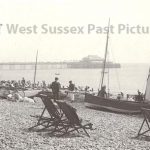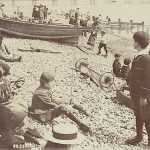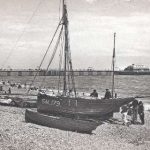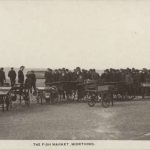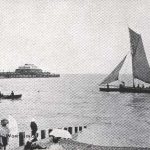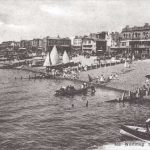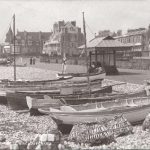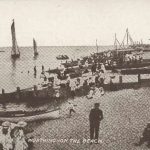1880 – 1930
Between 1880 – 1930 the fishing trade in Worthing was said to be thriving. Our fantastic volunteers have plumbed a range of resources, including magazines, newspapers, photo albums, censuses, guide books and a range of other materials, to bring to life the many tales, facts and figures of this exciting time in Worthing’s maritime history.
Postcards of the beach and Worthing’s fishing fleet
Credit to West Sussex CC Library Service www.westsussexpast.org.uk for the images
CENSUS STORIES
In 1871, there were 68 fishermen catching actively. Fishing family names included:
Adams, Ayling, Ayres, Bacon, Banfield, Bashford, Beck, Belton, Belville, Benn, Blann, Braden, Brown, Burtenshaw, Carter, Churcher, Edwards, Farley, Field, Freeman, Goble, Greenyer, Grevett, Hale, Harris, Harwood, Haylor, Head, Heather, Inkpen, Jeffree, Lee, Lucas, Marley, Marshall, Newman, Searle, Slaughter, Steer, Streeter, Tester, Trevatt, Upton, Wakeford, Wells, West and Whittington.
In 1871, there was one boat builder in Worthing, George Farrow. By 1891, there were 6 boat builders: Henry & John Belton, John Dowde, Benjamin Haslett, William Hutchinson, Charles Wilson, and 2 apprentice boat builders, Alfred & Herbert Belton.
In the 1881 census, it was noted that the popular roads in Worthing where fishermen used to live were: Gloucester Place (11 fishermen and 1 fish seller, including the Colliers and the Lees), Surrey Street (10 fishermen and 1 fish seller, including the Newmans and the Wakefords) and Chapel Street (6 fishermen and 1 fish seller, including the Edwardses and the Freemans).
In this decade, there were 76 fishermen catching actively.
By 1891, the demographic of the Worthing roads where fishing families lived had changed. Fishermen are fewer in number, whereas fish traders (hawkers, fishmongers etc) were more prevalent. The number of coastguards was fewer. There were numerous hawkers recorded at Travellers Rest and Volunteer Inn – of these, SULLIVAN, related to Carol, we know probably sold fish, as successive generations did. The Swan Inn was also a Lodging.
In this decade, there were 64 fishermen catching actively.
Some fishermen took other trades and some had died, leaving sons to continue the trade in some cases but not in all. There were more gas fitters etc as utilities became more available. William COLLIER is now listed as ‘Waterman’ and John GREENYER’s widow is ‘living on own means’ at Providence Cottage, Tarring Street.
Between 1871 and 1891 the number of sellers of fish (fishmongers, buyers, dealers, merchants, hawkers) grew from an estimated 9 in 1871 to 31 in 1891.
In 1871, there were approximately 47 fishing families working out of Worthing. By 1891, around 44 families were plying the trade.
Some family names appear throughout the decades from 1871 to 1891, including Bashford, Beck, Belton, Carter, Farley, Lucas, Marley, Searle and Streeter.
(Information from Worthing censuses, 1871, 1881, 1891)
In 1901, approximately 44 inhabitants of Worthing are employed as mongers, hawkers, merchants, dealers, clerks and assistants.
There is one Fish Fryer, William Linaham, who works with Christopher Locke, Fish Dealer, at 84 Montague Street. For decades, the street is the town’s busiest shopping area.
Approximately 6 fishing families live and work on Montague Street, while 7 live on Gloster (sic) Place.
Family names of fishermen include Bacon, Bashford, Beck, Benn, Blann, Burgess, Churcher, Clark, Cousins, Curwin, Davis, Field, Haylor, Riddles, Slaughter, Upton, Wakeford, West. The Beltons are registered as Boatbuilders.
(Information from Worthing censuses, 1901)
A SHRINKING FISHING FLEET
1849: 25 large boats fish off the South-East coast, and there are a number of smaller boats carry out inshore fishing (From www.british-history.ac.uk/vch/sussex/vol6/pt1/pp109-114).
1859: Only a decade later, the industry had declined, and is mainly confined to mackerel and herring fishing (From www.british-history.ac.uk/vch/sussex/vol6/pt1/pp109-114).
1887: There are four boats over 15 tons working from the harbour and 13 smaller boats. Fishing is mainly by drift nets and trawling (From www.british-history.ac.uk/vch/sussex/vol6/pt1/pp109-114).
1897: The fleet has shrunk to one large and seven smaller boats (From www.british-history.ac.uk/vch/sussex/vol6/pt1/pp109-114).
1903: Only 14 smaller ones remain (From www.british-history.ac.uk/vch/sussex/vol6/pt1/pp109-114).
TYPES OF BOATS THAT BERTHED IN AND FISHED OUT OF WORTHING
(from The Worthing Gazette, 18 June 1885)
-
Pleasure yachts – some had fish and prawn trawls on board.
-
Luggers
-
Herring boats
-
Rowing boats
-
Rowing dinghy
-
Ferry boat
-
Pair-oared skiff
BOATS BUILT IN WORTHING
From A Millennium Encyclopedia of Worthing History, D. Robert Elleray (Worthing: Optimus Books Ltd, 1998):
1856: The first lugger, the Ware, is built in Worthing.
1886: The Belton boatyard is opened by J Belton in Library Place.
1890: Belton’s yard builds a variety of craft, including fishing boats and the ‘Skylarks’ for Worthing, Eastbourne and Hastings, local yachts Britannia, Edna and Maude and luggers The Good Hope and The Consolation.
1916: Belton’s yard closes.
The Hutchinson family built boats in the town in 1873, while Benjamin Haslett plied the trade during the 1870s and 1880s. He later turned to house-building, as the town turned from fishing hub to seaside resort.
BRAVE MEN AND BOYS
1887: 93 men and 17 boys are employed in fishing (from article of 5 August 2010, newspaper unknown, Worthing Library).
1930s: Fewer than 30 fishermen work out of Worthing (from article of 5 August 2010, newspaper unknown, Worthing Library).
FOR THOSE IN PERIL ON THE SEA
1880s: Harry and Bill Blann, sons of Tom Blann, are both lifeboat men (from letter by Robert Blann, date unknown, Worthing Library).
1898: Bill Blann becomes Second Coxswain (from letter by Robert Blann, date unknown, Worthing Library).
1917: Harry Blann (jnr) is appointed Bowman of the lifeboat (from letter by Robert Blann, date unknown, Worthing Library).
1920: Bill Blann (jnr) is appointed Coxswain (from letter by Robert Blann, date unknown, Worthing Library).
1930: The lifeboat service is withdrawn from Worthing. Newspaper articles of the time show that Worthing was very saddened by the loss of this important service (from letter by Robert Blann, date unknown, Worthing Library).
MEMBERS OF THE LIFEBOAT CREW BETWEEN 1901 AND 1914
From Robert Blann’s book – in alphabetical family order
BACON, Steve
BELTON, George
BENN, George
BLANN, Bill (2nd Coxswain), Bill Jnr, Harry
BURDEN, Frank
BURGESS, Jack
COLLIER, Frank, Fred and William
COLLINS, Fred
COUSINS, William
CURREN, William
ELLIOTT, J
FINNIS, George
GROVES, James
HUTCHINSON, F
MARSHALL, Arthur, Fred, Harry and Mark
NEWMAN, George
STREET, Jo
WELLS, William
WINGFIELD Charlie, George, Steve(Bowman), Steve Jnr and Tom (Jumbo)
FISH STOCKS & CATCHES
From 1855 to 1864, the annual tonnage of fish landed and then transported on by train from the town fluctuates between 97 and 7 tons (From www.british-history.ac.uk/vch/sussex/vol6/pt1/pp109-114). Between 1882 and 1901, records show this has increased to between 123 tons and 10 tons.
1899: Nearly 170 tons of fish, excluding shellfish, is landed over the year (From www.british-history.ac.uk/vch/sussex/vol6/pt1/pp109-114).
1914: 52 tons of fish, excluding shellfish, are landed (From www.british-history.ac.uk/vch/sussex/vol6/pt1/pp109-114)
From ‘Falling off in the Fish Supply’, in Looking Around, an illustrated monthly magazine for family and general reading. January 1868-December 1879; April 1879; 12, British Periodicals pg. 282
“A few days ago I had a pleasant talk with a fishmonger at a well-known town on the south coast…..And what was the subject? The falling off in the quantity and quality of all kinds of fish. The supply is at least two-thirds less than it was twenty years ago….But whose fault is it if there is anything wrong about the state of the fishing trade?
“Well, the ‘trawlers’ accuse the ‘line’ men, and the ‘line’ men accuse the ‘trawlers’. Our friend condemns them equally. He says they have been destroying the supply for years. And he takes this matter so much to heart that he has put his views into print. …He refers to the advice given by some witnesses as to a ‘close’ season, but treats this with a sort of scorn… ‘While the trawlers and hookers are wrangling about who does the most injury, our fisheries are being destroyed by them and the seine and ward-net men. I have had thirty years’ experiences in the trade, and have made it my study… It is protection that is required…
‘A working man used to get fish for his family three or four times a week; at the present time he cannot get it once a month, the price being for fish which come to the working man’s table three times the price it was fifteen or twenty years ago – such fish as plaice, gurnet, ray, thornback, conger eel, mackerel and herrings. Who is the cause of it? Why, the fishermen, as they take all the young brood… I have been witness to the destruction not only from Brighton to Worthing, but from Worthing to Littlehampton. When it is taken by the seine and ward-nets, I have seen bushels of young soles, turbot, brill, red and grey mullet, codlings and plaice sold for a few shillings a bushel. I will ask if any one can be surprised that there is scarcely a turbot to be seen in a fleet of thirty or forty boats that go out from Brighton to the south fishing grounds?…’
“By all means let us have another commission, and let our friend be put upon it. He deserves the compliment, and we are sure would do the work well.”
1888: A bottle-nosed shark measuring 6ft was caught in the nets of the Secret.
1899: A catch of 4,000 mackerel were landed in Worthing at the beginning of the season.
1903: Only 22 tons of fish were landed at Worthing over 12 months, compared to 1,200 tons at Hastings and 800 tons at Brighton (The Worthing Sentinel, September 15, 2003).
1910: The first mackerel catch of the season is announced by shouts of “Mack-row! Mack-row!”
1912: “Our first consignment of mackerel this season was landed on the beach by two boats on Monday, but the number was small, and the fish accordingly commanded the substantial wholesale price of a a pound a hundred; whilst another fact which was scarcely likely to afford unqualified satisfaction was that this toil of the sea was not the reward gained by local fishermen, but was attributed to certain representatives of the industry at Brighton.” (Worthing Gazette, 1 May 1912)
CAUGHT HOOK, LINE AND SINKER!
“Local Fisherman Cautioned. – Mr E. B. Edwards was among the members present at a meeting of the local Committee of the Sussex Sea Fisheries District, held at Brighton Town Hall on Thursday. It was reported by the Chief Inspector (Mr. E. Page) that he found in the possession of a young fisherman at Worthing a lobster seven a quarter (sic) inches in length, which was less than the size prescribed by the Act; but as the alleged offender was said to have been fishing a short time only, it was decided to simply administer a caution to him.” (Worthing Gazette, 16 November
